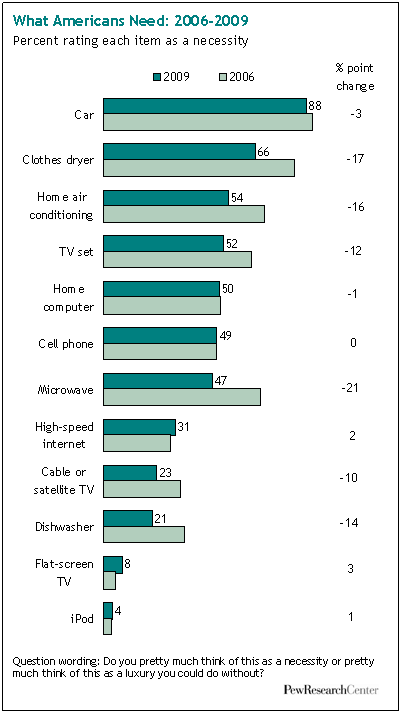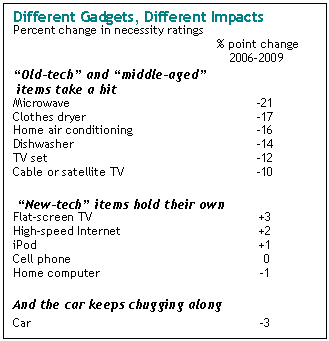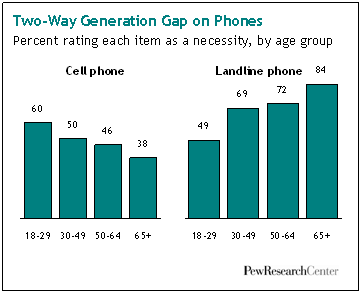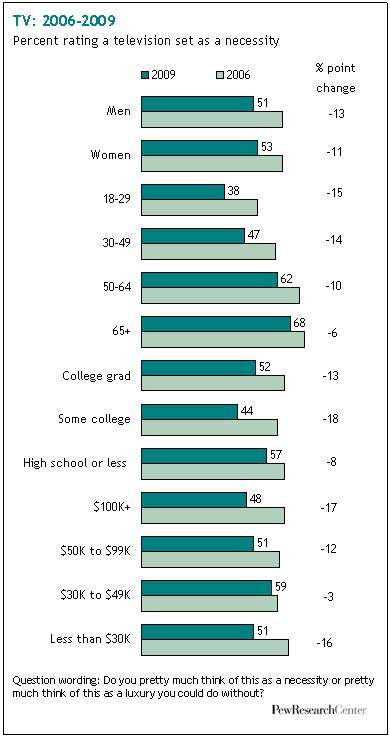
In hard times, the Pew Research survey finds that many Americans are changing their minds about which everyday goods and services they consider essential and which ones they could live without. The survey also shows that “old-tech” household appliances have fared the worst in the public’s reassessment of the line between luxury and necessity in their daily lives.
Of 12 items tested1, six dropped significantly in the necessity rankings from 2006 to 2009, while the other six basically held their own. All of the “old-tech” household appliances on the list dropped in their necessity ratings. For example, the proportion of people who rate a clothes dryer as a necessity fell by 17 percentage points in the past three years. There are similar declines for the home air conditioner (16 points), the dishwasher (14 points) and the television set (12 points).
A few of the “middle-aged” household appliances and services also declined. The microwave, a kitchen staple since the late 1980s, is currently viewed as a necessity by less than half the public, a 21-point drop in the past three years. The proportion who rate cable and satellite television service as a necessity fell 10 percentage points since 2006, nearly matching the declining value of a television set.

In contrast, none of the newer information-era gadgets and services has fallen in Americans’ assessment of what they absolutely need to have. Cell phones and home computers continue to be seen as a necessity by half of the public, unchanged from three years ago. High-speed Internet access is seen as a necessity by about three-in-ten adults, also unchanged from 2006. Two items that came onto the consumer scene in this decade — iPods and flat-screen TVs — are still seen as a necessity by a very small share of the public, but that share hasn’t declined during the recession.
Finally, there’s the automobile — the ultimate survivor. It’s been around for nearly a century, but in good times or bad, it retains its pride of place at the top of America’s list of everyday necessities.
Back to the Past
The question testing whether Americans judge specific consumer goods to be luxuries or necessities has been asked over many years by different polling organizations, beginning with the Roper Organization in 1973. A review of the results over time shows a noteworthy pattern: On many of the items tested, the public’s current “necessity” judgments have retreated to levels not seen for a decade or more. And on virtually every item for which a trend is available, the 2006 results represented a high-water mark in the necessity rankings. (Perhaps not coincidentally, 2006 was also the year before the recession set in and marked the outer limits of America’s housing bubble.)
For example, two-thirds (66%) of respondents in the latest survey consider a clothes dryer a necessity. That’s down from 83% in 2006 but nearly identical to the 69% who said in a 1983 Roper survey that a clothes dryer was a necessity. Similarly, about one-in-five rated a dishwasher as a necessity in the latest survey (21%) and in 1983 (19%) — a double-digit decline from the 35% who said three years ago that a dishwasher was essential.
(For more data from the 2006 study, see Luxury or Necessity?: Things We Can’t Live Without: The List Has Grown in the Past Decade.)
Despite the recession and roller-coaster gas prices, the trend data confirm that Americans’ dependence on the family car remains strong. Nearly nine-in-ten adults (88%) rate an automobile as a necessity. That’s virtually identical to the 90% who said the same in the 1973 Roper survey, and this proportion has hardly wavered in surveys conducted throughout the 1980s and 1990s.
Demographics of the ‘Necessity’ Reevaluations
Who has changed their minds about the need for a clothes dryer, a dishwasher, a television set or a microwave oven? A wide range of different groups, the survey finds. Regardless of age, gender, education and other social or economic characteristics, the change in attitudes toward these consumer goods has occurred quickly and broadly throughout the population.
For example, the proportion who consider a clothes dryer to be a necessity dropped 20 percentage points among men and 14 points among women; by 16 points among those younger than 50 years old and by a similar proportion of those 50 and older; by 16 points among those with a high school education or less and by 18 points among college graduates.
Double-digit declines also were recorded in perceptions of a microwave, home air conditioning and dishwashers as a necessity, regardless of respondents’ gender, age or levels of education. For example, in the past three years the proportion of the public that views a microwave as essential dropped by more than 20 percentage points among both the wealthiest respondents — those earning $100,000 or more — and those with incomes under $30,000.
That’s not to say that every core demographic group sees each of these items in the same way. Women are more likely than men to say an air conditioner is a necessity (59% vs. 49%), and this gender gap has grown from 3 percentage points in 2006 to 10 points in the latest poll. Women also are somewhat more likely than men to view a clothes dryer as a necessity (69% vs. 63%); three years ago, 83% of each gender said it was a must-have item.
While men and women may differ over whether air conditioners or clothes dryers are necessities, the gender gap on other consumer products has narrowed since 2006. Today, 20% of men and 22% of women say a dishwasher is a necessity; three years ago, more men (39%) than women (32%) considered it to be a household essential.
Similarly, in 2006, men were more likely than women to say that a microwave was a necessity (71% vs. 65%); in the latest poll, slightly less than half (47%) of both genders agree, with a larger proportion of men again changing their minds.
As for income differences, even though the declines in necessity ratings from 2006 to 2009 have taken place among all income brackets, higher-income adults — as in previous surveys — are more likely than lower-income adults to rate more of the items tested in the survey as necessities.
High Tech and Recession-Proof — So Far

The survey also finds that some consumer products, including some high-tech devices that have entered the marketplace relatively recently, appear so far to be “recession-proof.” About half of respondents in the current survey (49%) and a similar proportion in 2006 consider a cellular telephone to be a necessity. That overall finding obscures a considerable generation gap: Currently 60% of adults under the age of 30 say a cell phone is a necessity, compared with 38% of those 65 years old or older. But this generation gap is not significantly larger today than it was three years ago; in fact, views on the need for a cell phone have not changed significantly among any age group since 2006.
An equally dramatic generation gap opens when Americans are asked whether landline telephone service — the familiar home phone — is a luxury or a necessity. But this gap runs in the opposite direction. More than eight-in-ten (84%) adults ages 65 and above say a landline phone is a necessity, while only 49% of those younger than 30 agree. And younger adults are nearly four times as likely as older adults to say an in-home phone is a luxury (51% vs. 14%).

Are Americans Falling Out of Love with Their Televisions?
Clear majorities in polls conducted since 1973 have said that their TV set is something they couldn’t do without. Yet the latest Pew Research Center survey suggests Americans’ long love affair with their TV sets may be cooling.
Whether prompted by the recession or by the lure of new computers and other devices that can display TV programs as well as other kinds of streaming video, barely half (52%) of the public now say a television is a necessary part of their lives. That’s a decline of 12 percentage points since 2006 and the lowest proportion since 1973 to view a television as essential — even lower than the 57% who said a TV set was a necessity when the question was first asked in 1973.
Young adults have led the march away from the TV screen: Only 38% of those 30 or younger say a TV is a necessity, a 15-point decline since 2006. In contrast, perceptions of a television set as a necessity declined by just 6 points to 68% among respondents 65 or older.
A similar decline occurred in the past three years in attitudes toward cable and satellite television service. Today, less than a quarter (23%) of the public say such service is essential, down 10 points from 2006. But unlike attitudes toward television, views on cable and satellite service have declined more uniformly by age; if anything, it’s those 65 or older who are more likely to have changed their minds about it (a 13-point decline among those 65 or older, compared with an 11-point decline among those under 30).




